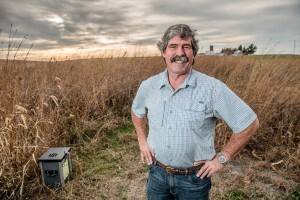 Guest post by Easton Kuboushek, Communication Specialist, Iowa Soybean Association
Guest post by Easton Kuboushek, Communication Specialist, Iowa Soybean Association
(article originally published in the January edition of the Iowa Soybean Review magazine)
Inventors and entrepreneurs are some of the most fascinating and creative people on earth. They have an uncanny way of looking at problems as opportunities and derive solutions through innovation.
Successful entrepreneurs say the key to success doesn’t come from a massive leap or stroke of luck. It comes from planning, hard work and most importantly — taking small practical steps.
Farmers are arguably some of the best entrepreneurs and creative problem solvers in the world. And they are certainly hard workers. Iowa Soybean Association (ISA) believes it’s time to put that tenacity to work and take small practical steps to improving Iowa’s water quality.
“Whether we like to admit it or not, everything we do affects somebody downstream,” says Rob Stout, farmer from Washington, Iowa. “We as farmers are part of the problem and I feel very strongly that we all have a role to play — we all need to step up to the plate.”
Stout and his stepson are conservation farmers operating 1,100 acres of corn and soybeans and raising 10,000 head of hogs in southeast Iowa. He implements a number of conservation practices — no-till, cover crops, terraces, buffer strips and a bioreactor — but it didn’t happen overnight.
Stouts journey to conservation success began in the early 1980s with some heavy rain and a little heartache.
“We saw some heavy spring rains and had some soil washout,” Stout recalls. “You know, it hurts to see that. I knew that even though we were doing conservation tillage at the time that it wasn’t enough.”

Stout took the first small step to solving his problem: learning about potential solutions. At the time, the practice of no-till was just coming into the farming scene.
“Washington County was really on board with no-till,” Stout says. “I went to a couple field days and liked what I saw.”
Stout switched his farm to no-till in 1983 and a few years later, was hosting no-till field days of his own. He continues to implement the practice today.
After starting with one practice, Stout built on his success with additional ones. He built terraces, waterways and buffer strips in the late 1980’s and nearly a decade ago began dabbling with cover crops.
“I think we started with 10 acres the first year,” Stout recalls. “Now we cover all but 20 acres with cereal rye, peas and radishes.”
Stout is in the eighth year of a 10-year cover crop study with Practical Farmers of Iowa (PFI) and Iowa Learning Farms. The remaining 20 acres are reserved as check strips to establish a baseline for the study.
Cover crops required more than just education for Stout. He recommends finding a trusted expert and other farmers to increase the chances of success.
Stout utilized his local Natural Resources Conservation Service (NRCS) office as a “one stop shop” for information on practices, projects and cost-share opportunities.
“Some counties are different but it’s important to find a partner you trust,” Stout says. “There are people who have successfully done it so don’t be afraid to ask questions — you don’t have to make every mistake other farmers have made.”
Iowa State University Extension and experts at the ISA also make excellent resources. Heath Ellison, operations manager of agriculture and natural resources on the ISA Environmental Programs and Services (EPS) team, emphasizes another set of eyes can be very beneficial.
“Try to find someone who can come in and help you see where you’re at,” Ellison says. “Start with that baseline assessment and get a third party looking at the operation— it’s always a beneficial conversation.”
Ellison and the EPS team work on water quality projects, many in collaboration with the NRCS, across the state.
“Often times, I’ll talk with farmers and we’ll find something we’re not ready to act upon — but at least we know where we stand,” Ellison says. “From there, we can build a plan and start organizing resources.”
Stout added working with neighbors can be a good solution to organizing the necessary resources, especially equipment. He rents out his drill to a few local farmers so they can plant cover crops.
“You don’t have to invest $50,000 dollars to get started. Hire somebody to do a field for you or do what you can,” Stout says. “There’s somebody who will be willing to do that — it just might take a little effort to find them.”
Stout’s work in conservation earned him the ISA Environmental Leader Award for 2017. And while his success and scope of sustainable practices is notable, he believes it’s nothing other farmers can’t replicate. In fact, he encourages it.
“These are things any farmer can do to save our soil and make the water cleaner,” Stout says. “Start small and work your way into it — we’ve got to do our part.”
 7 Steps to Incorporating Conservation
7 Steps to Incorporating Conservation
STEP 1: Education
• Attend field days or the ISA Research Conference
• Read and research through trusted resources
• Visit county Extension, NRCS or Soil and Water Conservation District offices
STEP 2: Find an Expert
• Who can help me be successful? Are there farmers near me?
• Identify and connect with a third-party expert
• Don’t be afraid to ask questions
STEP 3: Get an Assessment
• What practices will work on my farm?
• Have your expert look at your operation and identify which practices will work best
• Set a baseline to build upon
STEP 4: Build a strategy
• What’s the first small, practical step? How can I get there?
• What barriers do I have to adoption? How can I overcome them?
• Establish short term and long term goals
STEP 5: Organize Resources
• What resources do I need for implementation?
• Identify equipment, financial, seed and other resources
• Identify cost-share opportunities
STEP 6: Implementation
• Time to take action and implement your strategy
• Take small practical steps
• How will you measure progress? (i.e. water monitoring or stalk sampling)
• Track what works and what doesn’t work
STEP 7: Evaluate & Repeat
• What worked well? What didn’t?
• What adjustments do I need to make next year?
• Repeat and grow one small step at a time
Originally published in the January edition of the Iowa Soybean Review magazine
